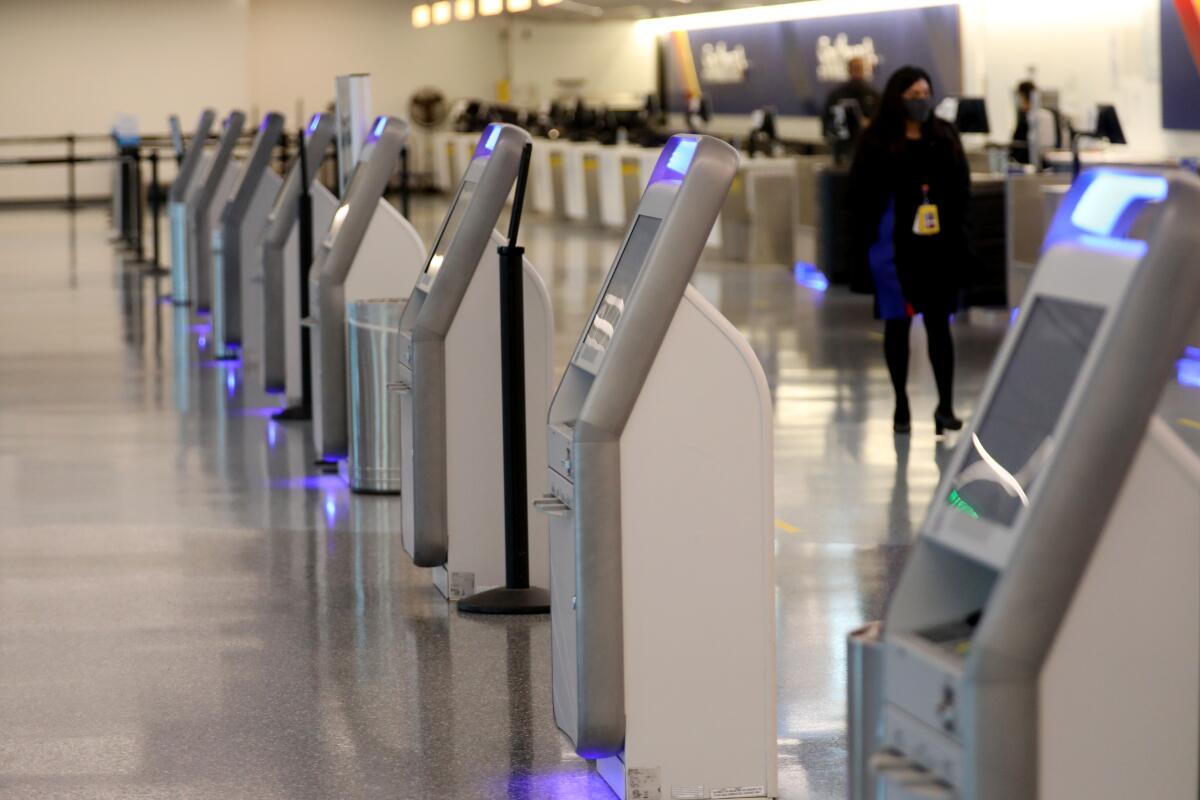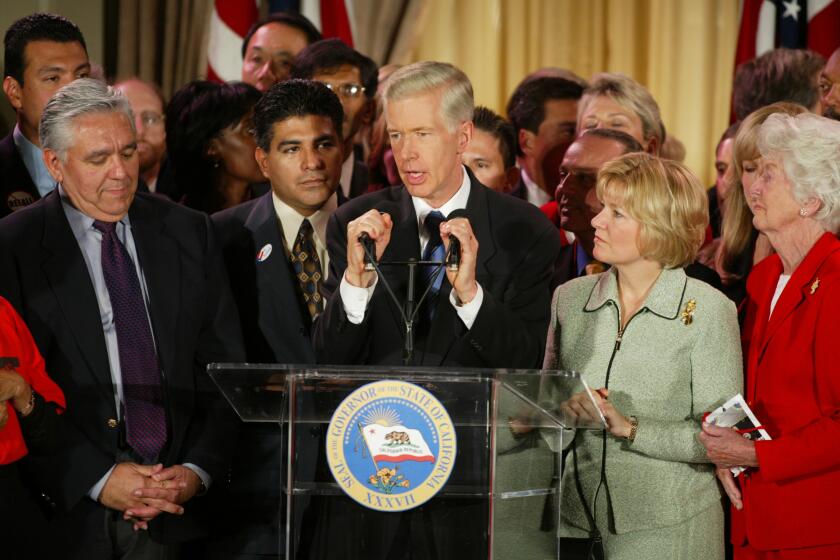Column: Airports to passengers: Do it yourself

- Share via
Workers have been losing their jobs to machines in the name of productivity and efficiency since the beginning of the Industrial Revolution.
But the pace of automation, 200 years later, is truly extraordinary.
I was reminded of that last week when I took my first overseas trip since the pandemic began.
For the first time, I didn’t see anyone around to help me when I arrived at Los Angeles International Airport and checked in for my flight at a self-serve kiosk. In the past, there’s always been someone there to assist the technologically incompetent.
It was the first time I didn’t hand my boarding pass to a human as I filed onto the plane. I merely scanned it and walked through an automatic turnstile, with no one present to check on me.
Returning home from Frankfurt, Germany, I printed my own luggage tags from a machine and then hoisted my bag myself onto an unmanned conveyor belt, where it was security-checked by a machine rather than a person and sent on its way. This is what the industry calls a “self-service bag drop solution.”
I can’t be sure, but based on what I’ve read, it’s possible that at both airports, my suitcase was conveyed to the plane not by workers but by robots. (Will that help reduce the number of bags delayed, damaged or lost each year — 24.8 million of them in 2018?)
Coming back through passport control at LAX, I stopped at yet another self-service kiosk. The machine took a photo of me, identified me from the image and OKd me for entry into the country. The ID was done through “biometric facial comparison technology” and involved no fingerprints, no passports, no questions. At the end, I handed a piece of paper to a guy who barely looked at it, saying only, “Welcome home.”
(U.S. Customs and Border Protection says machine identification cuts the processing time of a typical Global Entry passenger by almost 90%, from 45 seconds to less than 6 seconds. That means I gained 39 extra seconds to help offset the agonizing 20 minutes or more of crawling through traffic to get out of LAX and onto city streets.)
I probably should have been disturbed by the sci-fi creepiness of facial recognition. Or, conversely, I could have been exhilarated by the technological wonder of it all. Instead I was struck by how superfluous human workers are to the process.
Outside the terminal, passengers called for Ubers without the help of taxi dispatchers, and then were met by cars that we all know will soon drive themselves. Workers are scarce at the parking garages too, what with the ticket-dispensing machines, free-standing pay stations and automated gates.
How long before pilots are replaced by robots that fly planes more safely?
This is the world we live in. There’s nothing new about it or inherently wrong with it. The revolution in computing, robotics and artificial intelligence offers extraordinary benefits that only fools would reject out of hand. But while automation is clearly good for corporations and is presumably good for consumers, how is it for the baggage handlers?
LAX officials insist that in most cases, these automation changes don’t mean fewer jobs, often because new ones are being created in the process. But for travelers, “Do the work yourself” is the new mantra. The new technologies mean “the passengers themselves take care of most of the administration,” as one industry consulting firm put it, reducing the need for paid humans in many traditional roles.
The country, and indeed the world, is clearly headed for an extraordinary wave of robotization and automation — and not just in travel. In February, the McKinsey Global Institute predicted that 45 million U.S. workers would lose their jobs to automation by 2030. The pandemic sped up the transformation, the report found.
McKinsey had earlier concluded that as many as half the jobs people do in the world could theoretically be automated — including not just low-pay, relatively unskilled jobs but also many high-skilled white-collar jobs.
The optimistic view is this: History shows that technological advances can save labor time and costs, improve safety and efficiency, and benefit customers — while also spurring growth and generating more, new and often better jobs. There’s short-term displacement, to be sure; some jobs have been lost forever. But economists say the losses have been counterbalanced over time.
A 2020 report by MIT’s “Task Force on the Future of Work,” for instance, notes that 60% of all jobs done in 2018 hadn’t yet been invented in 1940. There were blacksmiths in the old days whose jobs were obviously rendered obsolete by technology, but on the other hand there were no TV repair people or solar panel installers — or, for that matter, airline pilots.
But some fear the disruption caused by automation this time around will be more intense and disruptive.
Gov. Gray Davis was removed from office in a recall election 18 years ago. What lessons did he learn?
McKinsey concluded that although the total number of jobs is likely to increase rather than decrease, that won’t necessarily protect low-skilled workers. Rather, it will require difficult, challenging transitions.
MIT’s report noted that the United States — unlike Sweden, Germany and Canada, among others — has failed to blunt the impact of technological change on workers. Unions have grown weak, leaving workers less able to protect themselves. The country has failed to redress job losses and has underfunded retraining programs. Other countries have more robust social safety nets.
MIT concluded that it is necessary to “harvest the dividends” of automation to deliver opportunity and economic security to workers in the form of broadly shared gains.
That seems obvious but also like the kind of thing corporations and policymakers could overlook in their rush to retool.
Ask the baggage handlers whether they’re worried, if you can find any.
More to Read
A cure for the common opinion
Get thought-provoking perspectives with our weekly newsletter.
You may occasionally receive promotional content from the Los Angeles Times.












